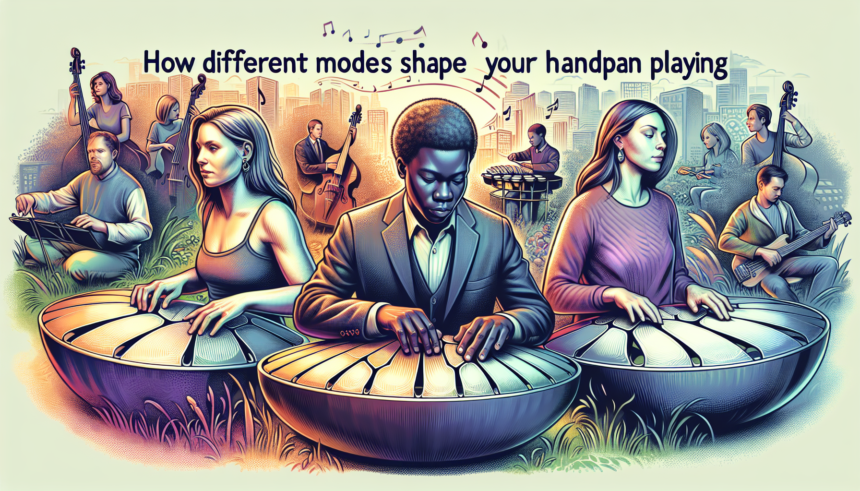The handpan is a relatively new instrument that has captured the hearts of musicians and listeners alike. Known for its ethereal sound, the handpan has a unique capability to convey emotion and atmosphere. One of the most influential factors in how a handpan sounds is the mode in which it’s played. In this article, we will explore how different modes shape your handpan playing, allowing you to unlock various tonal landscapes and emotional expressions.
The Basics: What are Modes?
In music theory, a mode is a type of scale derived from the diatonic scales. While the concept of modes can get complex, it’s often simplified for practical purposes in handpan playing. Modes have a significant role in shaping the mood, emotion, and character of your performance. Essentially, each mode is a sequence of notes that produce a distinct sonic atmosphere.
Major Modes
Major modes often evoke feelings of happiness, brightness, and positivity. Some of the most commonly used major modes in handpan music include:
1. Ionian
The Ionian mode is synonymous with the major scale. It has a joyful and uplifting character, ideal for compositions that seek to convey happiness and optimism. Playing a handpan in the Ionian mode will generally feel cheerful and forward-moving.
2. Lydian
The Lydian mode is almost identical to the Ionian, but with a raised fourth note. This small change creates a dreamy, somewhat mystical atmosphere. It’s a great mode for exploring bright soundscapes that still retain a hint of wonder.
Minor Modes
Minor modes tend to evoke melancholy, reflection, and introspection. These modes are frequently used to create deeper, more emotional music. Some important minor modes for handpan playing are:
1. Aeolian
The Aeolian mode is equivalent to the natural minor scale. It has a melancholic and often haunting character, ideal for passages that explore deeper emotions and introspection. The Aeolian mode can add layers of emotional depth to your playing.
2. Dorian
The Dorian mode is a minor scale with a raised sixth note. It combines the sadness of the minor scale with a touch of brightness and hope. Hence, it is a versatile mode, suitable for both reflective and more forward-looking pieces.
Exotic and Less Common Modes
Aside from the major and minor modes, there are other modes that bring unique textures and emotions into your handpan playing. Some of these include:
1. Phrygian
The Phrygian mode has a strong, somewhat dark character. Its flatted second note gives it an exotic, Spanish-like flair. This mode can be used to create tension and a sense of mysticism within your compositions.
2. Mixolydian
The Mixolydian mode is major with a flattened seventh note, adding a bluesy, slightly more grounded feel. It’s versatile and can be used in various genres, from folk to rock, to create a laid-back, comfortable feeling.
3. Locrian
The Locrian mode is the most dissonant of the modes. It has a flattened second and fifth note, giving it an unfinished, unstable sound. While not commonly used for an entire composition, it can be a powerful tool for creating tension and unresolved feelings in specific passages.
Combining Modes: Creating Unique Soundscapes
One of the joys of playing the handpan is the ability to effortlessly transition between modes within the same piece. This can be achieved through creative use of chords, progressions, and melodic lines. By combining different modes, you can craft unique soundscapes that shift in emotion and character.
For example, starting a composition in the Dorian mode and then transitioning into the Aeolian mode can take the listener from a place of hopeful contemplation to deep introspection, creating a dynamic and emotionally rich performance.
Practical Tips for Exploring Modes on the Handpan
Exploring different modes on the handpan requires both theoretical knowledge and practical application. Here are a few tips to help you get started:
1. Familiarize Yourself with the Scale
Before you begin playing, take some time to familiarize yourself with the notes of the mode you’re interested in. Play the scale up and down, getting a feel for its unique intervals and character.
2. Improvise Within the Mode
Improvisation is a powerful tool for internalizing the sound and feel of a mode. Spend time improvising melodies and harmonies within the mode, paying attention to how different note combinations affect the mood and atmosphere.
3. Listen to Examples
One of the best ways to understand how modes shape music is to listen to examples. Seek out handpan compositions that feature different modes and pay attention to how they convey different emotions and atmospheres.
4. Experiment with Transitioning Between Modes
Once you’re comfortable with a few modes, start experimenting with transitioning between them within a single piece. This can be done seamlessly by choosing modes that share common notes or can be used to create contrast and dynamic shifts in your performance.
5. Record and Reflect
Finally, record your practice sessions and performances. Listening back can provide valuable insights into how effectively you’re using modes to shape your music. It also allows you to identify areas for further exploration and improvement.
Conclusion
The handpan is an incredibly versatile instrument that allows for deep exploration of musical modes. By understanding and experimenting with different modes, you can shape your handpan playing to convey a wide range of emotions and atmospheres. Whether you’re aiming for joy, melancholy, mysticism, or tension, modes provide you with the tools to articulate your musical vision. With practice and creativity, you’ll find that the possibilities are truly endless.
Frequently Asked Questions
1. What is the best mode to start with for beginners?
For beginners, the Ionian mode is often recommended as it’s synonymous with the major scale and has a straightforward, happy sound. It provides a good foundation for understanding scales and note relationships.
2. Can I switch between modes mid-song on a handpan?
Yes, switching between modes mid-song is not only possible but can also add depth and variety to your music. Transitioning smoothly may require some practice, but it can significantly enhance the emotional impact of your composition.
3. How do I know which mode is being used in a handpan song?
Identifying the mode of a handpan song involves listening closely to the scale and interval patterns used. With some understanding of music theory, you can often pick out the characteristic intervals that define each mode.
4. Are certain handpans better suited for specific modes?
Handpans are typically designed with a specific scale in mind, so some may be better suited to particular modes. However, many handpans are versatile enough to explore multiple modes despite being tuned primarily to one.
5. Do modes affect the way I physically play the handpan?
The primary impact of modes is on the emotional and tonal quality of the music, not necessarily the physical technique. However, certain modes may inspire different playing techniques or patterns as you explore their unique characteristics.





